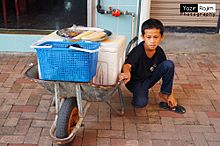Piutu facts for kids

A Tausug child vendor selling piutu in Sabah
|
|
| Alternative names | piyutu, putu |
|---|---|
| Course | Staple |
| Place of origin | Philippines, Malaysia |
| Region or state | Tawi-Tawi |
| Main ingredients | Cassava |
| Similar dishes | suman, puto |
Piutu, also known as piyutu or putu, is a traditional Filipino dish. It is a very important food for the Sama-Bajau people who live in the Philippines and on the east coast of Sabah, Malaysia. This dish is made from a root vegetable called cassava.
Contents
What is Piutu?
Piutu is a type of steamed cassava. People mash the cooked cassava and shape it into cylinders or flat disks. Long ago, people would wrap piutu in banana or palm leaves. Today, you will often find it wrapped in clear plastic when sold. When it's time to eat, piutu is usually torn or cut into small pieces.
Why is Piutu Eaten with Other Foods?
Piutu itself does not have much flavor. Because of this, it is always eaten with other dishes that have a strong taste. People often enjoy it with seafood. Some popular things to eat with piutu include:
- Latô salads, which are made from a type of seaweed.
- Kima, which are delicious giant clams.
- Siagol, a tasty stew made from shark meat and a yellow spice called turmeric.
The History of Piutu
Piutu is a replacement for rice in many meals. This happened after cassava was brought to the Philippines. Cassava came from South America during the time when Spain ruled the Philippines. This period is known as the colonial period.
Other Similar Dishes
There are other dishes that are similar to piutu and also replace rice. These include biamban and sianglag.
- Biamban (or bamban) is made from steamed tapioca flour. It is also shaped into cylinders and wrapped in banana or palm leaves.
- Sianglag (also called tompe, tompek, tinompeh, or anggang) is made from grated cassava. This grated cassava is fried until it turns a yellowish color.
Both biamban and sianglag are also eaten with savory dishes instead of rice.

